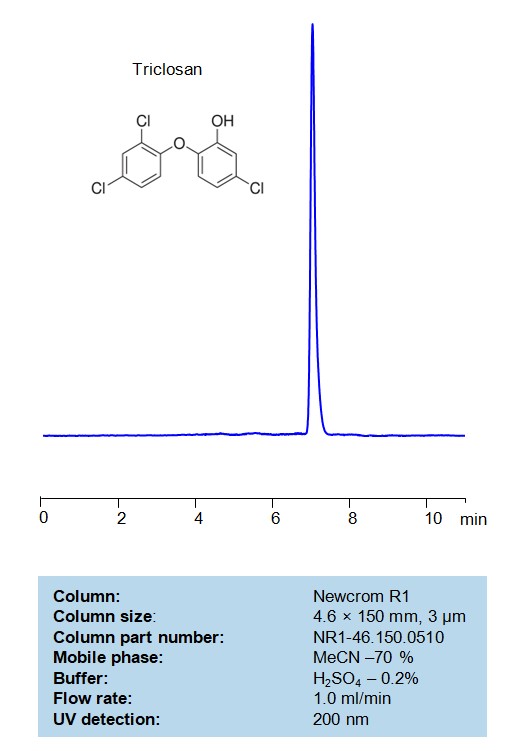HPLC Method for Analysis of Triclosan on Newcrom R1 Column by SIELC Technologies
Separation type: Liquid Chromatography Reversed-phase

Triclosan is an antimicrobial and antifungal agent that has been used in a variety of consumer products, including soaps, toothpastes, deodorants, and cosmetics, as well as in medical devices and textiles. Here are some key points about triclosan:
Mechanism of Action: Triclosan works by inhibiting the synthesis of fatty acids in bacteria, which are essential components of the bacterial cell membrane. Specifically, it targets the enzyme enoyl-acyl carrier protein reductase (ENR).
Controversy and Concerns:
Resistance: There have been concerns that widespread use of triclosan may contribute to antibiotic resistance, as bacteria that become resistant to triclosan might also become resistant to certain antibiotics.
Environmental Concerns: Triclosan is persistent in the environment and has been detected in various water sources. It can be transformed into other chemicals, like dioxins, when exposed to sunlight in aquatic environments.
Health Concerns: Some studies have raised questions about potential endocrine-disrupting effects of triclosan, particularly its impact on thyroid function. Additionally, its potential to contribute to allergic responses, such as skin sensitization, has been discussed.
Triclosan can be retained and analyzed on a mixed-mode Newcrom R1 column with a mobile phase consisting of water, Acetonitrile (MeCN), and sulfuric acid. This analytical method can be detected with high resolution and peak symmetry at a wavelength of 200 nm using UV detection
High Performance Liquid Chromatography (HPLC) Method for Analyses of Triclosan on Newcrom R1 Column by SIELC Technologies
Condition
| Column | Newcrom R1, 4.6 x 150 mm, 3 µm, 100 A, dual ended |
| Mobile Phase | MeCN/H2O – 70%, |
| Buffer | H2SO4 – 0.2% |
| Flow Rate | 1.0 ml/min |
| Detection | UV 200 nm |
Description
| Class of Compounds | Diphenyl ethers |
| Analyzing Compounds | Triclosan |
Application Column
Newcrom R1
Column Diameter: 4.6 mm
Column Length: 150 mm
Particle Size: 3 µm
Pore Size: 100 A
Column options: dual ended





